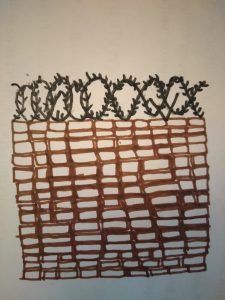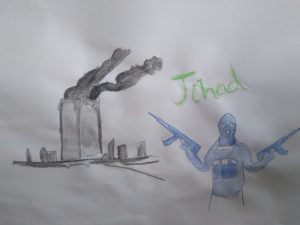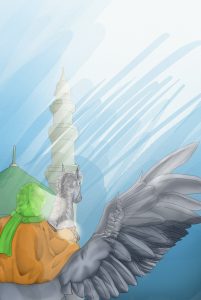Introductory Essay
ø
Having grown up in Pakistan, I have been surrounded by Islam my entire life. I personally belong to a religious minority, the Ahmadiyya, and got to experience the exclusive nature of the predominant Islam. As such, I came into the course with a decent understanding of Islam and the different strands that make it up. I was very aware of the history of change that Pakistan as a state went through from being envisioned to be a secular state by Jinnah to evolving into an Islamist nation, however, I was not aware of why this change took place. The course, “Multi-Sensory Islam” by Professor Asani really helped ground my experience of Islam and provide the vocabulary to define what I had seen growing up in Pakistan. Despite the different sides of Islam that I saw, I still had a very narrow experience of Islam and through taking this course I learnt how little I had known about the religion that I grew up with. From learning about Sufism to the fusion of Islam with Jazz in America, this course really taught me the value of aesthetics in Islam.
The course began with Professor Asani asking the class to rethink about what they experienced as Islam in their lives. The question that he asked in the beginning of the course about whose Islam we had experienced made me wonder what he meant by whose Islam. It was only through the next few weeks that I realized how there were different perceptions and experiences of Islam. It was not a monolith religion, as growing up in Pakistan had me thinking. Islam was not merely a religious ideology, divided into sects, but rather it was an instrument through which people over the ages have submitted to a greater superpower. Professor Asani placed a stress upon how Islam was a religion to be experienced and that Islam had existed even before the Prophet Muhammad was revealed the Quran and started professing the message of Islam through different prophets who called upon people to submit to God. It felt liberating to see a professor expanding the horizons of Islam and communicating how there were prophets whom Muslims associate with other religions like Krishna for Hinduism and Buddha for Buddhism. I felt grateful to be in an environment where such an analysis of Islam was accepted and openly taught. I know for certain, that the professor could not have taught this course in Pakistan due to role of religious ulemas and mullahs in censoring what can be understood as Islam.
A central theme of the course has been the distinction between the “loud” Islam and the “silent” Islam. The ulemas and mullahs who limit what can be understood as Islam and oppress those who want to experience Islam through a different lens are part of the loud Islam. My understanding was that the loud Islam was the problem. It was overwhelmingly taking the spotlight away from the inclusive and compassionate elements of Islam. The “silent” Islam which is not covered in the media was best portrayed to us through the professor recounting the tale of when he brought some American tourists to the shrine of Khwaja Moinuddin Chishti in Pakistan. After having an intense experience which left the Americans in tears but rejuvenated, one of the tourists asked Professor Asani that if what she just experienced as part of religious rituals at the shrine was Islam, then why hadn’t she seen it before? The same is true for me. Even though I grew as an Ahmadi, I only experienced the loud Islam. Growing up as religious minority that was outlawed, my religious experience was more influenced by the loud Islam than other Muslims because I got to see the side of loud Islam changing the perception of friends and neighbors who at once changed their attitudes towards me upon learning my religious affiliation. I got to experience how the loud Islam played with not only how people defined themselves but also with their psyche and attitude towards others. I learnt that the country I grew up in did not belong to me.
On the other hand, the religion that I grew up associating with, professed elements of silent Islam in certain ways while still excluding other elements of silent Islam. Where at one hand the women in our religion were allowed to go to mosques for prayers and encouraged to do so, they could not lead prayers. In class, we read about the New York activist who lead a congregation of men and women and it was really eye opening for me. I used to think that my sect, the Ahmadiyya, were the most modern and forward thinking in their attitudes towards preserving the rights of women but I realized that it was not true. However, the Ahmadiyya sect, does have a more modern understanding of Islam than other dominant sects. This can be seen in their role in converting jazz musicians in America to Islam. Clearly, the musicians realized that Islam and music did not stand at odds with each other and that their profession was cherished in Ahmadiyya Islam, which among other reasons, encouraged them to join Ahmadiyya Islam. However, like other religions, Ahmadis do not look favorably to the practices of Sufism like praying at the shrines of other Sufi saints. While there’s an acceptance of the practices and rituals associated with Sufism, praying to anyone else other than Allah is strictly prohibited in Ahmadi Islam. Another interesting fact that differentiates Ahmadis from other sects is that they cannot say prayers behind an Imam who does not believe in the prophet after Muhammad, Mirza Ghulam Ahmad.
We also learnt about Ahmadis in class, when Professor Asani talked about the crucial role they played in the creation of Pakistan and in relation to the foreign minister of Pakistan Sir Zafarullah Khan and the only Nobel Laureate of Pakistan, Dr. Abdus Salam. In class, we covered the Ahmadis briefly, talking about the laws imposed upon them under different regimes, like Zia-ul-Haq’s, where they were used as political instruments and where their rights to profess the religion they believed in were significantly curbed down. I wrote in depth about my experience growing up as an Ahmadi in one of my creative responses, “The Outlawed Sect” in which I convey the difficulties that minorities like the Ahmadis must experience growing up in an increasingly radicalized and Islamized country. Certain beliefs that Ahmadis hold distinguish them from other Muslims, the most important of which is the belief in a prophet after Muhammad. Another belief that is unique is about the idea of Miraj. Most Muslims believe that Prophet Muhammad physically travelled to the heavens whereas Ahmadis have a more reasonable understanding of the experience and believe it be a strictly spiritual experience. I portray the idea of “Light upon Light” in my representation of the experience of Prophet Muhammad’s Miraj in my blogpost “Ascent to Heaven”. The concept of Light hints at the primordial light that Muhammad represented, and how his Nur (Light) was given in bits and pieces to all the other prophets, those before and as an Ahmadi I have to say to the prophet after him.
This class is unique in its way of evaluating students. Instead of having academic essays, the class uses a mix of creative projects and short essays explaining these creative projects, standing true to its goal of having the students learn and portray their understanding of Islam through aesthetics and art. The first assignment we were asked to do was a Calligram project which involved integrating the name “Allah” into the project. For my illustration, I drew a caricature of a human being surrounded by two angels on the sides who are professing the name “Allah” into the human’s ears portraying the concept of accountability. It was meant to represent the role of angels in writing down the deeds of humans and communicating them to Allah on the day of judgement. Then for our mosque project, we envisioned building a mosque in front of the 9/11 memorial. By building a mosque next to the 9/11 memorial site, we wanted to convey the understanding of reconciling with the past and making people realize the distinction between those who were involved in the 9/11 attacks and what Islam stands for through a mosque that was open to all the members of the community. The inclusive nature of our mosque portrayed the teachings of the “silent” Islam, which is available for everyone to experience regardless of their sect and religious affiliation. Through the mosque project, I learned how to work with a group and the whole process of constructing a mosque gave me a better understanding of concepts like “Mihrab” and other communal aspects of a mosque. These communal aspects and the inclusive nature are missing from traditional mosques in Pakistan, which strictly serve members of a certain sect.
Another important takeaway for me from the course was the distinction between the Islam with the small “I” and the capital “I”. I learnt through the course that it was only after Quran was formally coded up that Islam with the capital I came to being. Islam was a religion to be experienced not an exclusivist ideology. Furthermore, the differences were cemented by going over how the process of colonialism gave a newfound understanding of Islam and other religions, which began to be used as labels, to create distinctions between groups of people. It was a profound experience to learn about the role of nationalism in creating a divide between different religious groups in the subcontinent and how boundaries came to be accepted as a norm in separating groups of people with different beliefs and faiths. For the class, we were expected to come up with a portfolio of creative projects, and my creative response to week 1, “Islam vs the West” highlighted many of themes that we have talked about like the loud and silent Islam. Through this response, I portrayed the effects of extremist religious ideology in Islam, in brainwashing individuals and creating barriers between Islam and the West. The West, in turn, started seeing Islam as no different than actions of a few individuals, who used the name of Islam, to terrorize others. The West began portraying Islam as a religion of war and conflict, creating an image of Muslims that has sparked Islamophobia and caused Muslims around the world to be persecuted and looked down upon for their association with Islam. It is in this context, that the silent Islam is missing from the status quo. The media only highlights the violent actions of those who associate with a certain extremist understanding of Islam, but the media does not show the more inclusive side of Islam.
Another important component of the course is the discourse on Sufi Islam. Sufi Islam represents the experienced Islam instead of the didactic Islam. The Sufi Islam is different from the “loud” Islam, in that it does not espouse the understanding of Islam as strictly reliant on Sharia law and is not exclusivist in nature. Poetry dominates Sufi traditions of Islam and for my portfolio, I wrote a poem, “God’s Love” to share my understanding of Sufism. In it, I profess love to God, by symbolizing him in the form of a human for whom I can have different forms of emotion, from affection and longing to love. Another creative response that used the medium of poetry was “The Nur Of Joseph” in which I recounted the journey of Prophet Yusuf and connected it with the pain that Hussein’s mother would have gone through upon seeing the blood-stained shirt of her son. It was my way of illustrating what I had learnt about “Ta’ziyah” plays in Iran, where creative renditions of the tragedy of Hussein’s death at Karbala are played out. The course placed an emphasis on the Shiite sect, and I would have liked to see the same emphasis placed on Ahmadiyya sect but there’s only so much that can be covered. It was interesting to me to learn about the Twelver Shia and the concept of the awaited twelfth Imam. It was fascinating to learn how different religions have all been waiting for the Messiah in different forms. The idea of the coming of the Messiah is so interesting to me because the prophet that we, Ahmadis, believe in, Mirza Ghulam Ahmad, claims to be the Messiah as well as the twelfth Imam and the manifestation of all the awaited prophets, like Isa. This idea of a “chain of prophets” ties into my creative response “Chain and Key to the Lock” in which I represent the different prophets, both known and unknown through a chain which is connected to a lock that symbolizes the Quran. The Quran which is meant to serve as the lock is the final word of God. Mirza Ghulam Ahmad, the prophet that we believe in, did not bring his own scripture. The Prophet Muhammad was the last prophet to have brought a scripture, and the Quran would stay to be the final word of Allah.
Overall, I learnt a lot through this course about a side of Islam that I did not know existed. Now, every time I come across religious calligraphy, my thoughts go back to all the videos that we have watched and the discussions that we have had in the class and sections about the evolving role of Islam in the world. Thank you so much for the experience and I truly hope that you enjoyed my portfolio. I had a great time creating it.





